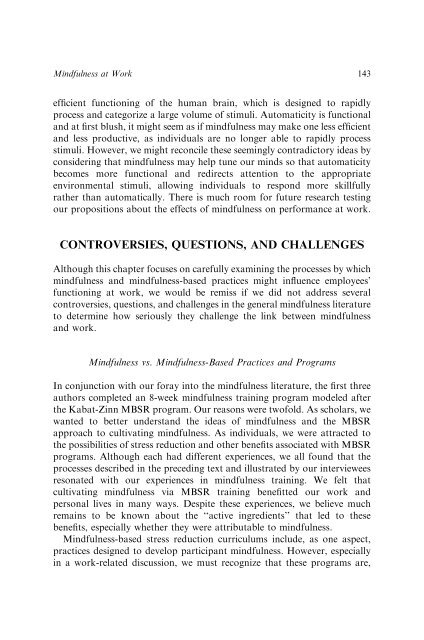Mindfulness at work (Glomb, Duffy et al, 2012) - Human Resources
Mindfulness at work (Glomb, Duffy et al, 2012) - Human Resources
Mindfulness at work (Glomb, Duffy et al, 2012) - Human Resources
You also want an ePaper? Increase the reach of your titles
YUMPU automatically turns print PDFs into web optimized ePapers that Google loves.
<strong>Mindfulness</strong> <strong>at</strong> Work 143efficient functioning of the human brain, which is designed to rapidlyprocess and c<strong>at</strong>egorize a large volume of stimuli. Autom<strong>at</strong>icity is function<strong>al</strong>and <strong>at</strong> first blush, it might seem as if mindfulness may make one less efficientand less productive, as individu<strong>al</strong>s are no longer able to rapidly processstimuli. However, we might reconcile these seemingly contradictory ideas byconsidering th<strong>at</strong> mindfulness may help tune our minds so th<strong>at</strong> autom<strong>at</strong>icitybecomes more function<strong>al</strong> and redirects <strong>at</strong>tention to the appropri<strong>at</strong>eenvironment<strong>al</strong> stimuli, <strong>al</strong>lowing individu<strong>al</strong>s to respond more skillfullyr<strong>at</strong>her than autom<strong>at</strong>ic<strong>al</strong>ly. There is much room for future research testingour propositions about the effects of mindfulness on performance <strong>at</strong> <strong>work</strong>.CONTROVERSIES, QUESTIONS, AND CHALLENGESAlthough this chapter focuses on carefully examining the processes by whichmindfulness and mindfulness-based practices might influence employees’functioning <strong>at</strong> <strong>work</strong>, we would be remiss if we did not address sever<strong>al</strong>controversies, questions, and ch<strong>al</strong>lenges in the gener<strong>al</strong> mindfulness liter<strong>at</strong>ur<strong>et</strong>o d<strong>et</strong>ermine how seriously they ch<strong>al</strong>lenge the link b<strong>et</strong>ween mindfulnessand <strong>work</strong>.<strong>Mindfulness</strong> vs. <strong>Mindfulness</strong>-Based Practices and ProgramsIn conjunction with our foray into the mindfulness liter<strong>at</strong>ure, the first threeauthors compl<strong>et</strong>ed an 8-week mindfulness training program modeled afterthe Kab<strong>at</strong>-Zinn MBSR program. Our reasons were twofold. As scholars, wewanted to b<strong>et</strong>ter understand the ideas of mindfulness and the MBSRapproach to cultiv<strong>at</strong>ing mindfulness. As individu<strong>al</strong>s, we were <strong>at</strong>tracted tothe possibilities of stress reduction and other benefits associ<strong>at</strong>ed with MBSRprograms. Although each had different experiences, we <strong>al</strong>l found th<strong>at</strong> theprocesses described in the preceding text and illustr<strong>at</strong>ed by our intervieweesreson<strong>at</strong>ed with our experiences in mindfulness training. We felt th<strong>at</strong>cultiv<strong>at</strong>ing mindfulness via MBSR training benefitted our <strong>work</strong> andperson<strong>al</strong> lives in many ways. Despite these experiences, we believe muchremains to be known about the ‘‘active ingredients’’ th<strong>at</strong> led to thesebenefits, especi<strong>al</strong>ly wh<strong>et</strong>her they were <strong>at</strong>tributable to mindfulness.<strong>Mindfulness</strong>-based stress reduction curriculums include, as one aspect,practices designed to develop participant mindfulness. However, especi<strong>al</strong>lyin a <strong>work</strong>-rel<strong>at</strong>ed discussion, we must recognize th<strong>at</strong> these programs are,


